Restaurant Marketing in 2024: 29 Powerful Ideas and Trends
Restaurant Marketing Techniques to Grow Your Restaurant Business in 2024 and Beyond
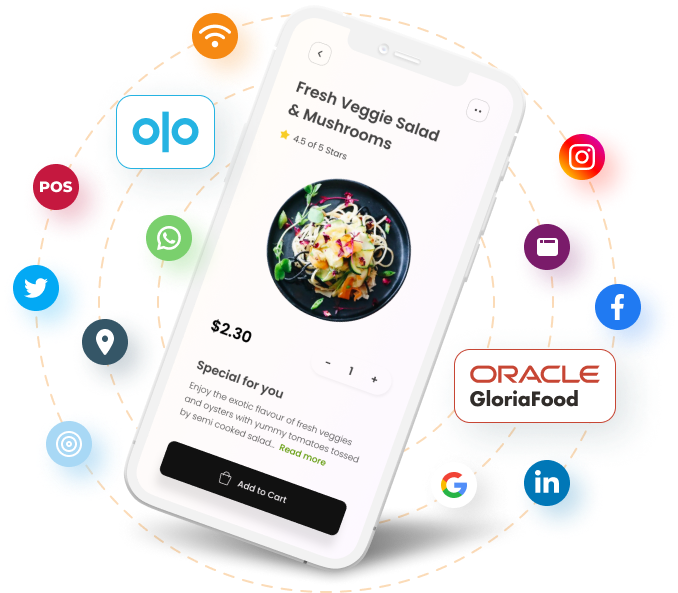
Scroll to explore
29 Restaurant Marketing Ideas, Tips, and Trends for 2024
Restaurants face challenges in establishing their identity in a landscape saturated with dining options.
Economic hurdles further intensify this struggle, underscoring the pivotal role of cost-effective marketing as the key to overcoming these obstacles.
The essence of innovative restaurant marketing extends beyond attracting new guests. It hinges on maximizing the impact of every marketing dollar spent.
Restaurant marketing tools and technology emerge as business accelerators. They can reduce costs, unlock guest insights, and establish owned communication channels that drive revenue as efficiently as online companies.
At the same time, a successful restaurant marketing strategy demands constant evolution to align with the ever-changing landscape of restaurants and shifting consumer preferences.
While traditional marketing methods maintain their relevance, the evolution of restaurant marketing requires marketers to craft new, data-driven campaigns that actively engage guests.
These points create unique opportunities and challenges for CEO’s, COO’s, CTO’s, and restaurant marketers that may sometimes seem overwhelming.
Restaurant Marketing Infographic

Restaurant marketing techniques in 2024 range from AI and guest WiFi to customer data platforms, online ordering, websites, review sites, Google My Business, email, SMS, and advertising—innovation is not just a choice but a necessity.
This page lists restaurant marketing strategies, ideas, and technologies to help elevate and automate your marketing in 2024 and beyond.
From fast-casual marketing to fine-dining marketing, as you branch out into various marketing channels, it is essential to maintain a consistent brand voice and personality.
Likewise, aim to keep your look and feel as consistent as possible, including imagery across all digital marketing channels and customer touchpoints when executing marketing for a restaurant.
1. Artificial Intelligence as a Force Multiplier
Utilizing Artificial Intelligence (AI) in restaurant marketing has become an increasingly popular way for restaurants to gain a competitive edge.
AI can help restaurants better understand guest behavior, analyze guest data, and create highly targeted campaigns tailored to their needs and preferences.
AI for restaurants can automate marketing automation, content personalization, and customer segmentation tasks.
By using AI in restaurant marketing, businesses can save time, money, and resources while better understanding their guests and creating more effective campaigns.
Additionally, AI can help create more meaningful guest interactions and experiences by providing them with personalized content and marketing communications.

For example, Bloom Intelligence allows you to use AI to identify guests at risk of never returning to your restaurant based on their previous behavior across your locations, online orders, or reservations and then trigger an offer to bring your once-lost guest back.
This example shows how a restaurant marketer can use AI to automate marketing to a targeted segment of your guests with personalized marketing at the right time and place, resulting in tangible ROI.
Another great example is using AI to generate responses to your online reviews. Mid-size brands can spend 10-20 hours a week responding to reviews across various online sites.
Now, with AI, restaurant marketers or operators can automate the process of replying to reviews with AI-generated review responses that consider the voice of your brand, templates, and the actual review.
This example results in meaningful review responses and automated processes to bring guest recovery strategies offline to make the guest happy again.
Imagine what you could do with 10-20 hours of your time a week given back to you.
Another use case for AI is analyzing your reviews across Google, Facebook, Yelp, Trip Advisor, and direct survey responses to generate AI guest sentiment reports. These reports take on complex tasks, make them easy, and allow you to quickly identify operational issues, such as unclean bathrooms, that you can resolve quickly, creating higher guest satisfaction.
Then, use positive guest insights in your marketing automation on your first-party channels, such as email marketing or SMS marketing, using the actual voice of your guest to build guest loyalty and increase guest lifetime values.
AI can turn hours into minutes and provide exponentially better results.
2. Invest in a CDP
As a marketer, you understand the importance of knowing who your patrons are and how they behave both online and offline.
Gathering guest data from as many sources as possible is essential to acquiring these key insights.
A restaurant customer data platform (CDP) is a convenient tool that streamlines the process of aggregating, cleaning, and centralizing guest data and behavior from various sources into one platform, saving valuable time for restaurant operators.
Types of integrations or guest data pipelines into your CDP include but are not limited to guest WiFi, websites, social media, POS systems, review sites, reservation systems, loyalty programs, and online ordering platforms.
A CDP allows restaurant marketers and operators to discover and visualize guest insights and group similar guests into lists, segments, or audiences, such as your regulars or at-risk guests.
A CDP can significantly boost the ROI of your restaurant’s marketing and advertising efforts by leveraging guest audiences. It achieves this by enabling personalized messaging tailored to the specific needs and preferences of these guest groups, thereby enhancing guest engagement.
Restaurant CDPs give restaurateurs a full 360-degree view of their guests’ behaviors, orders, contact information, geographic locations, and demographics across all channels and at your physical locations.
A CDP like Bloom Intelligence provides a comprehensive 360-degree view of your guests’ behaviors, orders, contact information, geographic locations, and demographics across all channels and at your physical locations. This single customer view (SCV) empowers you to make smarter, data-driven marketing and operations decisions, thereby enhancing your overall business performance.
Automating the process of building your CDP from first-party opt-in customer data from your WiFI, websites, online ordering, reservations, and reviews (and other sources of guest data) builds lists of your guest segments (such as your regulars and at-risk guests) that you can remarket to for life. Guest lists are pure gold—on-demand sales.
Having a CDP will allow you to be more effective with online advertising. With the elimination of cookie-based online targeting expected soon, having first-party data is the only way to remarket to your guests and create lookalike campaigns (for example, of your high-value guests) on platforms like Google and Facebook Ads.
More importantly, you can migrate or blend your marketing with owned channels such as email, SMS, or push notifications to engage your guests. This will allow you to increase guest frequency, personalize your guests’ dining experience, win back lost guests, find new customers, and improve your online ratings at a fraction of the cost of paying for advertising or access to other online platforms.

3. Understanding the Value of a Customer Data Platform (CDP).
You can group your guests into various segments using a CDP based on their behavior and demographic data.
Segmentation allows restaurants to create personalized marketing messages that speak individually to each guest in the group. For instance, you can send a special offer on a guest’s birthday or a survey after a guest leaves your restaurant.
This level of personalization boosts engagement and can significantly improve marketing ROI over sending out a single mass message to your entire database.
A report from SmarterHQ indicated that 72% of consumers only engage with marketing messages tailored to their interests, highlighting the significance of segmentation in delivering personalized content.
A CDP, a user-friendly tool, provides a straightforward way to understand which guests are regulars or at risk of churning, which are high-value, and which are low-value to your operation.
It also provides insights to make better marketing and operating decisions.
Now that you have an accurate single customer view, you can create messaging that will resonate with your potential and existing guests and turn all your guests into regulars.
By leveraging a CDP, you can increase repeat business, personalize your guest experiences, automate marketing, improve online ratings, and much more.
These restaurant marketing strategies have the potential to turn all your guests into regulars, fostering customer loyalty and driving business growth.

4. Use Your Guest WiFi
In today’s fiercely competitive food and beverage industry, knowing who your guests are and how they behave is vital when effectively marketing for a restaurant. Personalized marketing, powered by a CDP, is the key to staying ahead in this competitive landscape.
First-party guest data lets you personalize and segment your marketing campaigns for better engagement and a higher ROI.
But how do you collect guest data at your physical locations when your time is so limited?
Simple. Use your guest’s WiFi.
With WiFi access points, your patrons can be tracked individually by their device’s WiFi signal, whether they log into WiFi or not.
This means that even if a guest doesn’t log into your WiFi network, you can still collect WiFi analytics about their visit, such as the time they spent in your restaurant and the areas they visited.
You’ll have immediate access to behavior data such as:
- Daily traffic
- Customer dwell times
- Dwell times by the hour
- First-time customers
- Repeat customers and repeat rates
- First-time customer repeat rates
- Popular days and times
When guests do log in to your WiFi, you can collect even more data about them, such as:
- Customer age and gender
- Postal code
- Income distribution
- Phone number
- Birthdate
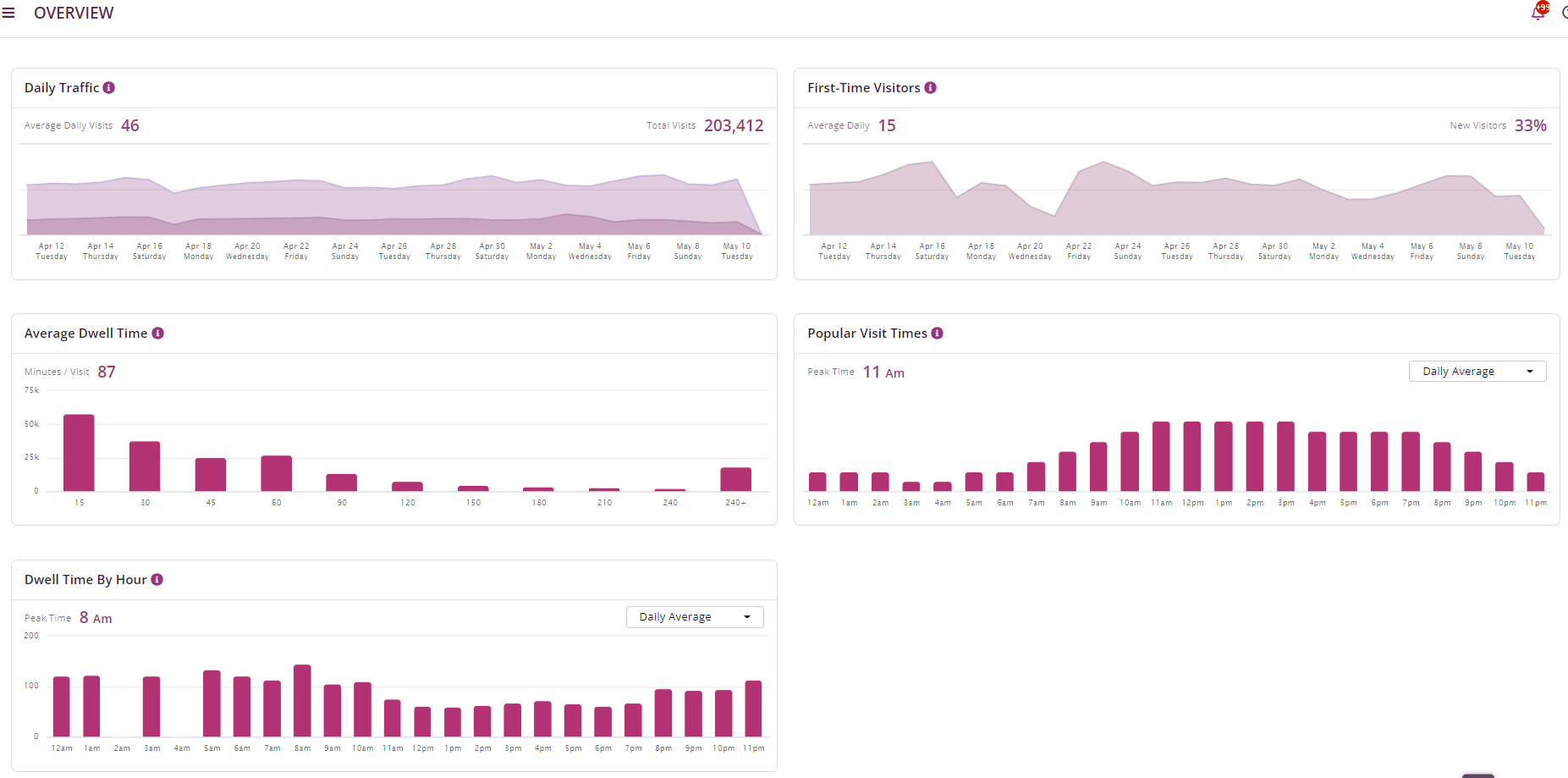
Then, you can use this unique data set to segment your customer list and market to each segment and not only increase engagement but also ROI.
Plus, you can track attribution down to a customer walking back into your door and redeeming an offer.
With WiFi access points, the platform can sense every visitor who enters your place of business with a smart device.
When your guest logs into your WiFi, the guest device is associated with a guest profile. This allows you to easily understand your guest behavior at your restaurants.
All of this is also known as WiFi marketing.
5. Online Ordering Data Collection
There is much competition in the restaurant industry. It can be challenging to attract customers and keep them returning for more. But there is one way to help ensure more consistent business – taking orders online.
Online ordering for restaurants saves your guests time and makes your life easier as a restaurant owner. You don’t have to worry about hiring extra staff to take phone calls or wait on people at the counter.
Over the last several years, online ordering has become very popular in restaurants, and the trend shows no signs of slowing down.
By integrating your online ordering system with a CDP like Bloom Intelligence, you can collect and store the unique data you collect in individual guest profiles for online ordering marketing.
Online ordering data will build your CDP significantly faster than just one source of guest data, like guest WiFi.
By integrating online ordering into your CDP, you will be able to see additional guest data and behavior in guest profiles, such as orders, online ordering behavior, addresses, and much more. This additional guest data will power your marketing automation capabilities to provide more ROI.
Since 2014, online food ordering has grown 300% faster than dine-in. If you’re not offering online ordering to your guests, now is the time to generate additional revenue and capture and collect guest data to supercharge your restaurant marketing.
All in all, this is one strategy that could have a significant impact on your restaurant business, both for data collection and for an additional revenue stream.

6. Reservation’s Guest Data
Reservation data is another resource that provides guest data and behavior, which can help you build your guest lists and CDP faster.
When analyzed and applied effectively, this rich source of information can offer great insights into guest behavior and preferences. This, in turn, enables restaurants to design more personalized, impactful marketing campaigns that can truly captivate your guests and drive their loyalty.
When guests go online to create a reservation, systems like OpenTable require them to enter certain information to complete the reservation.
Types of guest data include:
- Names
- Phone numbers
- Emails
- Wedding anniversary
- Reservation day and time
- Reservation completed day and time
- Number of guests
- Orders (if tied to the point of sales)
Guest data is effortlessly gathered during online reservation creation. This data is then seamlessly integrated into a guest’s customer profile in your CDP, whether it’s an existing profile or a new one created for a first-time guest.
Likewise this opens up an opportunity to add reservation system marketing to your arsenal.
It’s not just about being tech-savvy; it’s about being truly customer-centric. By harnessing the power of reservation system data for personalized marketing, and triggering marketing, you can forge meaningful connections with your customers.
This approach enhances their experience and keeps your restaurant competitive in today’s dynamic industry.
7. Rating and Review Sites
On popular online review sites like Google, Facebook, Yelp, and Trip Advisor, your guests share their experiences and feedback about your restaurants. These reviews are more than just feedback. They are a unique opportunity to connect with your customers on a deeper level.
By integrating these platforms into your CDP, you can tap into this wealth of information and use it to drive operational and marketing improvements.
Types of data include:
- Names
- Reviews
- Number of reviews
- Date and time of reviews
If used correctly with AI, you can use this data to understand your guests’ sentiments or the “voice of the guest.” From bathroom cleanliness to menu preferences, your guests’ feedback is a goldmine of information.
With the power of AI, you can effortlessly sift through hundreds or even thousands of reviews, generating a comprehensive management report that can be directly utilized for operational improvements. This streamlined analysis enables you to swiftly identify both issues and opportunities.
The value of comprehending this data cannot be overstated. It represents the collective voice of your guests, providing a unique opportunity to fine-tune your operations and tailor your marketing efforts to their preferences. Harnessing this data can truly transform your business.

8. Use Your Website
Your company website is the digital epicenter of your brand.
When considering your restaurant, most guests will visit your website to see your menu, look for testimonials (social proof), or get a feel for the overall guest experience.
Consumers go online to see your menu, order take-out, discover upcoming specials and events, and more.
A website form is an opportunity to collect guest data into your CDP.
Examples of guest data that you can collect:
- Names
- Phone numbers
- Emails
- Wedding anniversary
- Age – Birthday
- Gender
- Favorite Location
- Postal Codes
Website forms can be used to contact your restaurant, sign up for your email list, or join your loyalty program.
Your website should also be the source of your brand identity regarding look, feel, and personality. This branding should then be consistent across all online and offline customer touchpoints.
Integrating as many sources as possible of guest data and behavior into your CDP allows you to build your guest list faster, provide a single customer view of all your guests across all interaction points, and ultimately provide a way to drive revenue to your restaurants.
9. Implement Proper SEO
Focusing on your ranking on Google, Bing, or other search engines can maximize website traffic and attract new guests.
Improving website rankings is known as search engine optimization (SEO) and achieving the number one position on search engine rankings can provide significant traffic to your websites and locations.
Providing original, educational, entertaining, and compelling value-focused content for your guests is crucial.
Make sure to include keyword phrases your guests would be searching for, such as Italian Restaurant in Atlanta. Ensure the keyword phrases flow naturally in a sentence and don’t sound forced.
Write naturally and focus on providing value and information about your restaurant, opening hours, and menu, and you should be fine.
It is also important that other websites link to yours.
Find local directories and listings, such as Google My Business, Apple listings, or Yelp, that will increase awareness of your restaurants, menus, and hours and create links back to your website.
You can also use tools like SEM Rush or Yoast to rank and provide guidance on improving your website’s SEO.
An intelligent way to think about SEO and link building is that if you publish entertaining, educational, compelling content on your website, others will naturally link back to it. By creating compelling and educational content, search engines will naturally rank your website higher over time.
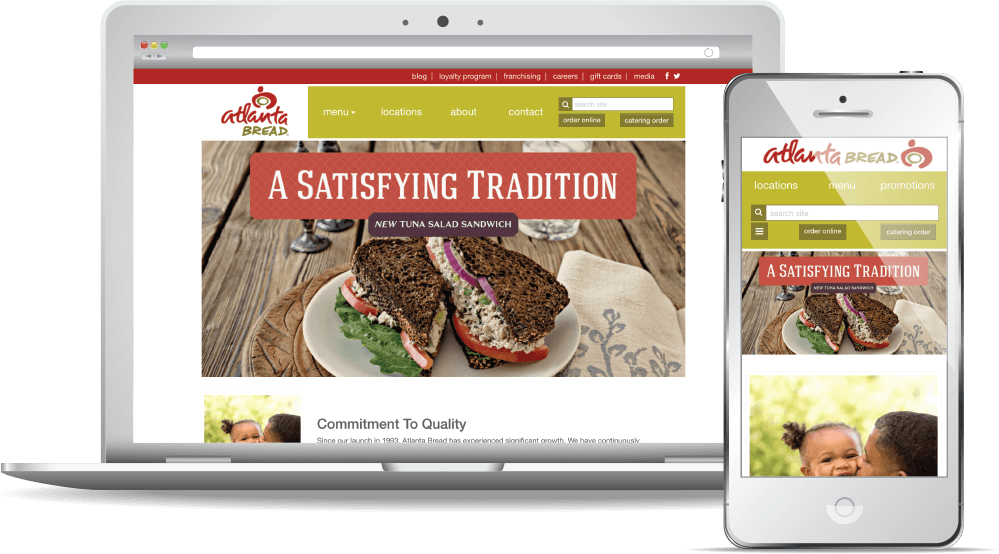
10. Restaurant Marketing Automation
Owned Channels
Owned marketing channels are the cheapest, and arguably the most effective form of marketing a restaurant marketer can use to drive sales. These channels include your website, email, SMS, mobile apps, and push notifications, which you control.
Building a CDP and creating segmented audiences and audience lists are powerful tools that empower restaurant marketers or operators, putting them in the driver’s seat for their marketing strategies.
As a marketer, you use these lists across your owned channels to drive sales for life, owning these customer profiles across all of your owned channels at a fraction of the cost of any paid channel or platform.
Using a CDP plus marketing automation for your restaurants means you can create personalized experiences for your patrons, making them feel valued and important. This is your cheapest and most effective form of marketing.
Integrating a wide range of guest data and behavior into your CDP is key to unlocking unique marketing opportunities.
This comprehensive approach allows you to surprise and delight your guests through automated or triggered marketing, enhancing their experience and driving loyalty.
Examples of automated marketing triggers sending offers, messages, or surveys that take into account guest behavior across your location, online orders, websites, review sites, and point of sales include:
- Bring Back Lost Guests – have guests stopped returning or ordering online? Send a triggered message with a reminder and incentive to get them to return.
- Milestone – send one-time messages, offers, or surveys based upon visiting a location or making an online order X number of times.
- Loyalty – send repeating messages, offers, or surveys based upon visiting a location or making an online order X number of times.
- Birthday – surprise and delight your guests with a triggered birthday message.
- Wedding Anniversary – show your guests appreciation by sending an automated anniversary message.
- Upon Exit – send automated messages to your guests when they leave your physical location
- Upon First Registration – this email will be sent when a guest first registers with your reservation system, online ordering system, or guest WiFi.
- Upon Order – send an automated message a specific period of time after a guest orders online.
- Upon Reservation – send an automated message a specific period of time after a guest makes or completes an online reservation.
Or you can send one-time messages, offers, or surveys to:
- Create an e-newsletter to send out monthly specials or updates about upcoming events at the restaurant.
- Send out promotions such as “buy one get one free” deals.
- Announce new menu items by sending out announcements and coupons via email.
- Update existing patrons about your new menu or upcoming events.
- Send out thank you notes to loyal customers and ask them how they enjoyed their experience at your restaurant.

You can utilize the segmentation of your guest lists in your CDP to target regulars or infrequent guests.
Maybe you want to target guests who ordered a specific menu item in the last three months with an offer for that specific menu item to bring your guest back or suggest a similar high-profit complimentary menu item. The options are endless.
The main point is to keep your guests engaged and your restaurant top-of-mind with your local patrons.
Remember to keep your restaurant marketing plan relevant by offering coupons for favorite foods, special discounts for returning customers, prizes for frequent diners, or surprises and delights on birthdays or anniversaries.
Suppose you don’t build a customer list with contact information, demographics, behavior, and important dates to your guests, like birthdays and anniversaries, in your CDP. In that case, you’re simply leaving money on the table.
If you use a comprehensive CDP, marketing automation, and reputation management that resides in one platform, you can automate the collection and utilization of this data and trigger marketing to your guests across platforms.
AI and automation make once time-consuming and complex tasks easy, freeing up your time for other important tasks. Plus, you can save a significant amount of money by not operating multiple platforms that do not communicate with each other.
Pro-tip: make sure any platform you choose provides a white glove experience. You can validate the ease of using a platform and the software’s customer service with a simple search to see what their customers say about these platforms online.
The combination of your CDP, audiences, personalization, and marketing automation will drive sales when you need them most, with the lowest cost per acquisition for a new order at your restaurants.
11. Restaurant Marketing Attribution
Marketing attribution in the context of restaurant marketing is the process of assigning credit to individual marketing tactics and messages and then applying ROI to them. In simpler terms, it’s about understanding which specific marketing efforts are driving the most value for your business.
When executed with precision, restaurant marketing attribution empowers marketers, enabling them to strategically focus on tactics and messaging that yield the best results.
Likewise, it will identify where less focus is warranted.
By embracing marketing attribution, you open the door to significant improvements in media efficiency and ROI. According to Gartner, businesses typically experience a 20-30% boost in media efficiency and a corresponding increase in ROI. This potential for growth and success is within your reach.

Applying marketing attribution to your marketing campaigns makes sense. But you’ll need accurate, reliable, and comprehensive guest data updated in real time. This real-time data is crucial as it allows you to make timely and informed decisions, ensuring that your marketing efforts are always relevant and effective. Otherwise, you will be just wasting time and money.
Bloom is a leading provider of an all-in-one restaurant marketing platform, including a customer data platform, marketing automation, and reputation management.
One of its key features is setting up and automating at-risk offers, which are sent to guests who have been identified as lost by AI or after a specific amount of time not being seen at your restaurant and have not been seen making an online order. Bloom’s marketing automation will trigger an offer to your lost guest. Bloom will then track this offer down to the guest clicking on the email, walking back in your doors, and actual redemption.
Tracking your marketing attribution from campaigns shows that a campaign has been effective, such as seeing that you have saved 38% of your lost guests. However, it can also go deeper by showing the actual lifetime value of all guests recovered.
This transparency into the effectiveness of your campaigns allows you to continue to optimize your messaging and offers to maximize your ROI from every campaign sent.
12. Customer Loyalty Programs
Restaurant customer loyalty programs are enormously popular in restaurants all over the world.
Owners and operators know this guest-engaging marketing strategy can expand their customer base and extend their guests’ overall average lifetime value.
Implemented effectively, a loyalty program has the power to convert sporadic visitors into regular patrons, boosting the per-person average and ultimately, the bottom line.
The audience may be smaller regarding your overall marketing efforts, but that shouldn’t discourage you. In many cases, a loyalty program or mobile app only has the most loyal customers who have opted in.

Loyalty program opt-ins can represent 5% of your customer base. For instance, some well-performing loyalty programs have seen opt-ins ranging from 10% to some superstars enrolling up to 50% of their customer base.
Even though loyalty program enrollment represents a smaller portion of your total guests, participants are typically very loyal guests who can impact your bottom line by increasing their frequency and spending.
As a result, they expect and are ready to receive your offers, updates, coupons, and messages. These guests want to interact with your brand, which is a valuable opportunity for you to deepen your relationship with them.
A way to solve the inherently limited reach of a loyalty program and get to a broader base of your guests to understand and market-based upon the guest persona (for regular, semi-regular, at-risk) is to integrate the loyalty program into a CDP along with all the sources of your opt-in guest data so that you can gain a single customer view by persona or audience that you can market to across owned (email, SMS, or other channels) or unowned channel (online advertising).
13. Social Media for Restaurant Marketing
Social media is a relevant way to engage with your guests and potential guests around your menu items, ambiance, or events.
Even if you do not have pages on popular social media channels like Facebook and Instagram, you can bet that your guests are posting, tweeting, and Instagramming things about your restaurant.
You can also bet that potential guests are reading it.
The more engaged you are with your clientele, the more loyal they become, and the more they’ll spread the word with user-generated content.
A well-developed restaurant social media marketing plan can bring a large percentage of business through your door.
14. Facebook
From making improvements to driving sales, customer engagement is imperative when you market a restaurant.
But what if you need a social media audience? There are many ways to engage fans over social media. Here are some tips for boosting your Facebook followers:
- If you do not have a Facebook group, consider making one. If you have a Facebook group but do not participate, start. This engagement gives you a built-in audience to respond to the content you share.
- When you need people to like your page or join your group, you could host a contest. To get 100,000 likes on their Facebook page, Qwertee gave away 1,000 free shirts in a week. This approach works when you have multiple platforms to expand your content. Create graphics, videos, blog posts, and more that people can share to spread the word. 35% of Facebook fans will like a page so that they can enter contests.
- Videos in less than a minute can have significant results. The best length for Facebook engagement is around 1 minute and 30 seconds. Facebook users watch 100 million hours of video each day. Your videos could be about anything from promotional content to food and drink items to a behind-the-scenes look at your restaurant.
Engaging your audience doesn’t have to be complicated. In fact, it can be as simple as conducting fun polls. By asking people to decide between your two most popular desserts and making the sharing process easy and enjoyable, you can encourage them to interact with your content.
Remember, people love sharing their opinions, and when it’s fun and effortless, they’re more likely to participate.
15. Instagram
Photos and videos are a win-win for social media, especially Instagram. There is an opportunity to engage with influencers who can promote your business on Instagram or other social networks.
Or share exciting videos of your kitchen preparing a meal—the key to being engaging and visual.
If enough people like your video or picture, you can go viral. According to Collins Dictionary, going viral means “if a video, image, or story goes viral, it spreads quickly and widely on the internet through social media and email.”
Imagine the thrill of your restaurant being exposed to millions of people in a short span of time. This is the power of going viral on Instagram or other social media outlets. While it’s not easy to achieve, when done correctly, it can have a significant impact on your bottom line. So, don’t underestimate the potential for exposure and visibility that these strategies can offer.
Other ways to extend the reach of your social media could include:
- Attract guests with shareable photos and videos on your WiFi landing page. It’s the first thing they see, so make the sign-in worth it.
- Make your splash page social-friendly with like, share, pin, and tweet buttons.
- Spread the word by asking guests to check in with social sites when they sign into your WiFi.
- Engage guests with shareable deals customized for each social media site so their friends can share.
- When guests exit your WiFi landing page, point them to a social media page to engage with your content.
- Embed social media images or videos on your website.
- If you have digital signage – rotate images from your social media pages.
All these capabilities help build positive connections between your guests and the members of their social networks. To measure the success of your social media efforts, track metrics such as engagement rate, reach, and conversions.
This will give you insights into what’s working and what’s not, allowing you to refine your strategies for better results.
16. X (Twitter)
X is another excellent platform for restaurant marketing. It allows you to post images and text, so you can share a quick message with any image you’d like to share.
Twitter allows you to engage with your guests using quick, simple messages. It is an excellent option if you’re short on time and want to start quickly.
Engaging with your guests on social media sites like these not only builds a sense of community but also shows that you value their feedback and opinions, which can lead to increased customer loyalty and sales.
17. Restaurant Paid Advertising
Paid advertising is a sophisticated marketing strategy that requires a financial investment. It’s considered advanced because it involves complex targeting, personalized ad creation, and detailed performance monitoring.
Google (Google Ads) and Meta (Facebook Ads) are popular paid advertising channels.
These can be powerful, as your campaign can be configured with unique targeting features, personalized ads, and a thorough dashboard to monitor and analyze results.
You can even tell them the type of person you want the ads to display based on their browsing history or demographic information.
Google Ads
Google Ads is the most used and popular online paid advertising platform for marketing a restaurant.
When you search Google, you often see advertisements at the top and the bottom of the results page. These are Google Ads, and you can advertise your restaurant in this space.
Google and Facebook Ads offer you the power to configure where and to whom your ads are displayed. This means you can target your ads specifically to searchers who are within a specific distance of your restaurant(s), giving you full control over your advertising strategy.
Once you’ve created your ads, you can tell the system which searches you’d like your ads to appear on.
There is no limit to the number of search phrases you can enter. When someone searches for any of the words, your ad will appear.
Then, you set a budget cap. You’ll never pay more than the monthly cap you set, and you can adjust it or pause the campaign anytime.
Ads are displayed in order using a Google algorithm that considers the search term’s relevancy and the maximum bid per click you have set in the system.
As mentioned above, this is an advanced strategy for many restaurateurs.
Monitor your account’s performance regularly. Tailor your settings to appear as high on the search page as possible without spending too much per click.
Google Ads can produce powerful results, but attention should be paid to the account to ensure your monthly budget cap can be spent with a high ROI.
Facebook Ads
Facebook Ads are very similar to Google Ads. You can configure them as straightforward or as complex as you like.
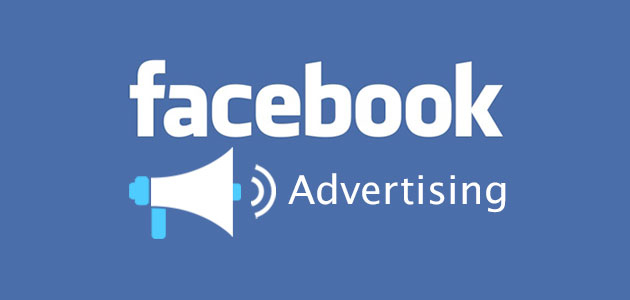
With over 2 billion people using Facebook monthly, you can use behavioral, demographic, and even likes and dislikes to narrow your desired audience to the type of guest you want the ads to appear to.
Facebook Ads are generally less expensive than Google ads. However, Google Ads can reach a much larger audience.
You Must Know Your Audience for Online Advertising
Understanding your audience is not just important, it’s crucial for any marketing campaign. The best campaigns start and end with the audience in mind, and this knowledge can be the key to your restaurant’s marketing success.
Since a restaurant’s paid advertising is an investment, it’s crucial to ensure you gain the highest ROI possible. Accurate targeting and personalization can help you achieve this, potentially leading to increased revenue for your restaurant.
You need accurate, reliable, and comprehensive data about your ideal customer profile to do this.
With a restaurant CDP, you can gain a comprehensive view of your guests across all platforms they interact with. This allows you to use advanced segmentation techniques, such as creating lists of high-value regulars, to match your ideal customer profile.
Then, take these lists, export them, and import them into Google or Facebook to retarget existing customers or create look-a-like campaigns to find new guests.
18. Implement Targeted Remarketing and Lookalike Campaigns
Another strategy is remarketing for restaurants, which involves re-engaging with customers who have interacted with your restaurant in the past. You can do this by uploading their names and email addresses into the Google Ads or Facebook/Instagram system to serve them targeted ads.
These platforms allow you to upload your guest names and email addresses into their system and create ads that will be shown to them when on Google or Facebook/Instagram.
Likewise, you can create “lookalike” campaigns. When you upload your customer list – just as you would for a remarketing campaign – you can tell Google and Facebook to analyze your list and only serve ads to people with characteristics and demographics similar to those on your list.
By knowing your target audience and using lookalike ads to target similar potential guests, you can find new customers faster without spending money on mass advertising campaigns.
19. Restaurant Reputation Management
Bloom Intelligence integrates with Google, Facebook, Yelp, and TripAdvisor. Anytime a guest makes a review on these platforms or through a direct review request, these reviews are all pulled into the platform for easy management of reviews along with detailed reporting.
The ability to respond to reviews, generate automated reports, and see guest sentiment trends using Bloom artificial intelligence will liberate you from hours of tedious work per location per week or month.
Some partners save up to 20 hours a week across their multi-unit brands. They do this by automating responses with templates, AI, and rules or by automating detailed guest sentiment reports that they share with their c-suite or even boards. Saving this much time allows these teams to focus on execution, improving operations, or focusing on guest satisfaction—not just manual work or analysis.
Imagine what you can do with 20 more hours a week given back to you.

20. Automated Review Responses
Have you ever contemplated how much time you could reclaim if someone else managed your review responses?
Bloom takes care of this task for you, freeing up 15-20 hours weekly to concentrate on other vital aspects of your business operations.
Identifying the time required to respond to reviews consistently, we’ve created a time-saving solution tailored especially for restaurants.
By leveraging Bloom Intelligence, you can create templates with your brand’s voice, AI, and rules. The platform will then automatically monitor and respond to your reviews, ensuring that guest feedback is addressed promptly and consistently, leading to improved guest satisfaction.
Creating systematic processes to bring negative reviews offline so that you can make it right and ask your guest to change their review or delete this review only improves your overall ratings and guest sentiment.
Plus, responding to all reviews shows your guests that you care. This results in your guests’ loyalty, ultimately affecting your bottom line.
Implementing a reputation management platform like Bloom Intelligence not only improves your online reviews but also creates social proof. This social proof, in turn, attracts new guests to your restaurants, enhancing your online discoverability and driving new business.
21. Use AI to Suggest Meaningful Responses
When responding to reviews, navigating several websites and responding efficiently to every new review can sometimes become tedious.
Bloom aggregates your ratings and reviews from Google, Facebook, Yelp, and TripAdvisor. All your reviews are on one platform, allowing you to monitor and respond to them from within a single platform—updated in real time.
When manually responding to these reviews, you will see an icon above the response field. When you click on the icon, several AI-generated responses will become available for you to choose from.
You choose the best response, edit if you wish, and click Reply.
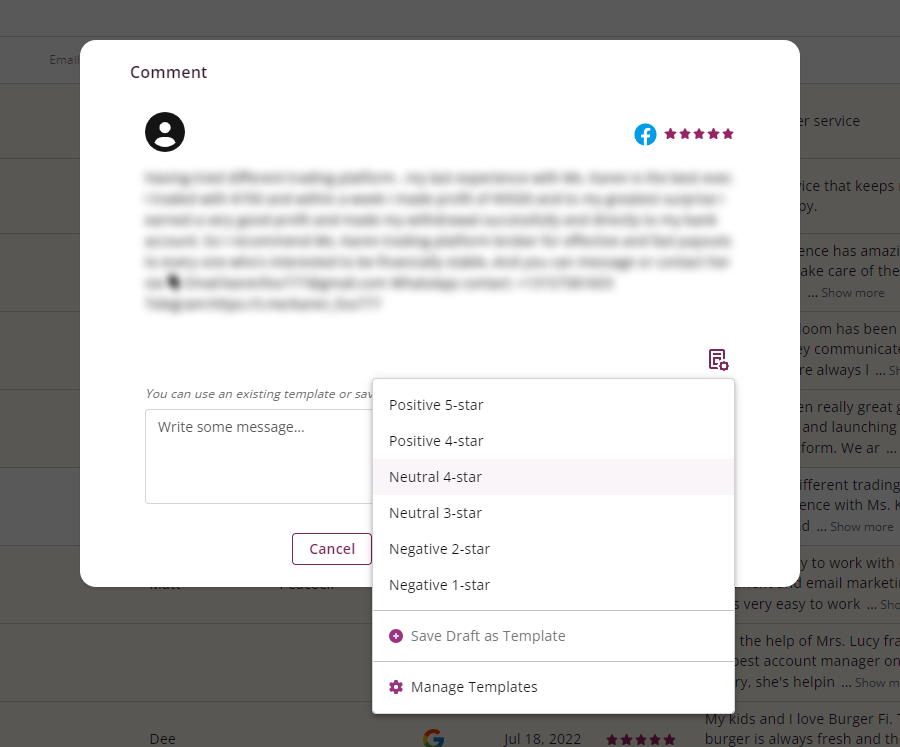
The AI-powered system analyzes each review and suggests a personalized response based on the context and sentiment. You can accept or modify the suggested response to better suit your needs.
Better yet, over time, the system will learn from your edits and continue providing responses that are more to your liking. It will also consider the voice of your brand when responding to reviews.
22. Showcase Your Social Proof
Bloom can also generate a small piece of code to place on your website. The code will display an unobtrusive pop-up to show your website visitors your aggregate rating on Google, Facebook, Bloom, or any combination.
A rating widget is a great way to show social proof to your website visitors, driving more net new business and helping to improve your restaurant marketing results.
23. Ratings and Reviews Websites
In today’s digital age, reviews are available instantaneously to anyone with an internet connection.
When searching for a restaurant or hotel online, customer reviews on these popular sites are among the first to appear in the search results.
Because of this, many potential guests make up their minds about the quality of an establishment as soon as they see the highlighted rating appear on their screen before they’ve seen any marketing materials, visited the location’s website, or even visited the location itself.
TripAdvisor receives a staggering 390 million unique visits a month and has 435 million available reviews on nearly seven million restaurants, accommodations, and attractions.
Yelp attracts about 174 million monthly mobile and desktop visits, with about 115 million posted reviews.
This popularity clearly shows the importance of using these sites so your restaurant can find new guests. Given these numbers, staying on top of your ratings and reviews on these powerful websites is essential.
24. Use Customer Sentiment Analysis to Improve Your Guest Experience
Ratings and reviews are a great way to measure customer sentiment. They allow you to identify specific issues, spot trends over time, and apply them to your restaurant marketing strategies.
Then, you can use that data to improve your business.
For instance, you may see a consistent flow of reviews saying that the lighting in your dining room is too dim during dinner service. You can add more lighting and then watch future reviews to see if the issue and your customers’ experiences have improved.
Lighting is just one example of using customer sentiment to improve your business. The opportunities are truly endless.
The issue is that it can take a lot of work to study all of your reviews consistently.
Bloom uses artificial intelligence to measure customer sentiment. It uses all your Google, Facebook, and Bloom reviews and displays them in an easy-to-understand word cloud.

Positive sentiment is green, neutral in grey, and negative in red. The larger the word or phrase, the more it appears in customer reviews.
Using color to identify positive and negative sentiments makes it simple to measure customer sentiment and improve your business over time.
At the same time, Bloom provides qualitative AI that can summarize all reviews, negative reviews, and positive reviews and even provide advice by location or grouping of locations.
AI guest sentiment reports save a significant amount in analysis and reporting.
25. Restaurant Surveys and Feedback Loops
Using Bloom Intelligence’s advanced automated marketing suite of tools, creating a survey with an automated feedback loop is quick and easy.
Bloom users create surveys to send to their guests. This message will typically thank them for a recent visit and ask them to rate a specific part of their experience – from one-half star to five stars with the ability to leave a comment.
Here, you can find some restaurant survey questions you could configure.
You can configure a message to be sent after a specific number of visits to your restaurant or an online order, so they do not get it after every visit.
Set a rating threshold and an automated follow-up email will be sent if the threshold is met.
For instance, if the threshold is set at 2 ½ stars, a follow-up message can automatically be sent if the guest gives a rating of 2 ½ stars or less.
In this case, the follow-up message would apologize for providing anything less than stellar service. It can include an incentive to get the guest back through your door for that valuable second chance.

The Marketing Payoff
The idea is to grab the guest’s attention and resolve their issue before they reach an online review website.
Suppose the guest knows their issue is being addressed in a friendly and positive manner. In that case, they will most likely refrain from complaining online.
Over time, this will mitigate many negative reviews that would have been sitting online – damaging your reputation – for years to come.
Likewise, if the guest gives a good rating in the initial message, you can follow up with a message thanking your guest and asking them to refer a friend or bring a friend next time with the attached offer.
Over time, this will significantly increase the number of positive ratings and reviews online, resulting in more new guests coming through your doors.
Are you worried that raising prices will make your loyal customers leave and not return?
Set up a survey to automatically send to your guests two hours after they leave. If they give you a negative response, incentivize them with an offer to bring them back.
26. Business Listings
Google My Business
Google My Business is a tool that’s not only free but also designed to be user-friendly, making it easy for restaurants and brands to manage their online presence across Google, including Search and Maps.
With Google My Business, you gain more control over your company’s information, which in turn, makes it a breeze for potential customers to find you. This increased visibility can lead to a significant boost in customer attraction.
Google allows you to manage your information and appears when someone searches for your brand name or your Google Maps location.

Once set up, Google will add your details to its search results when users search for your restaurant online. Likewise, your restaurant may also appear when users search for your type of cuisine or atmosphere (e.g., sports bars near me, Italian restaurants in New York).
If you already have a GMB account, consider using their reservations option so your customers can make reservations online or connect to your existing reservations software like OpenTable. Some restaurants see a 20% increase in online reservations using this simple technique.
By verifying your information with Google My Business, you’re not just improving your online presence, you’re also enhancing your reputation. In fact, businesses that do this are twice as likely to be considered reputable by consumers.
To claim your business on Google My Business, all you need to do is create a free Google account (if you don’t already have one), log in, and proceed to claim your business. It’s a straightforward process that can kickstart your journey to improving your online presence.
You’ll immediately be able to enter all of your company information. You can even create events and posts appearing in your search results.
You can also post your menu, use Google’s free online ordering for pick up or delivery, or even schedule reservations.
You can use the same process on Apple Maps, Bing, and other search engines or listing sites. Since Google provides the vast majority of search traffic, Google My Business should be your priority.
The good news is that you can manage your Google My Business and Facebook business listings directly within Bloom Intelligence. You can also take hours off your work week when updating descriptions or your hours all in one location.
If you have spent hours updating your multi-unit brand hours and descriptions on listing platforms, you understand this pain point vividly.
If you are marketing a restaurant, this is an integral part of your marketing strategy. It is also great for attracting new guests.
27. Local Media, Magazines, and Newspapers
By taking your marketing efforts offline, you are covering all your bases.
Publishing in newspapers and local magazines can sometimes be pricey, so you want to ensure your advertisement reaches as many people as possible.
The best days to have your ad run are Sundays and Fridays.
Coupons are the main attraction on Sundays, so consider adding a coupon or special in the Sunday paper.
Likewise, Fridays are the days when local events and happenings are published. So, think about Friday as another option.
Pro tip: It’s essential to target your ideal customer profile. Use your CDP to identify the demographics and behavior of your guests so that you advertise in magazines or newspapers whose readership matches your ideal customer profile, such as your regulars.
Using your ideal customer profile will save you money and increase ROI.

28. Influencer Marketing to Boost Your Restaurant’s Visibility
In today’s social media-driven world, partnering with influential figures can be a powerful way for restaurants to reach a highly engaged audience.
By collaborating with personalities who resonate with your target diners, you can amplify your brand’s reach, build trust, and drive more customers to your establishment.
The secret to successful influencer marketing lies in finding the right influencers whose values and offerings match your restaurant’s. This can be done by researching websites that can match you with local influencers.
For example, Social Curation will link local brands with local influencers for local partnerships.
Or, you can scour the social media platforms that your patrons frequently visit, looking for those with large followings.
When selecting influencers, it’s essential to understand your target audience. Food bloggers, local celebs, and Instagram foodies with a significant following in your area can be excellent partners. By thoroughly examining their content, engagement levels, and audience details, you can ensure a perfect fit, empowering you to reach your audience more effectively.
After finding influencers, it’s important to set clear goals and expectations with them. They can genuinely promote your key selling points. Invite them to free tastings. Have them share honest thoughts with photos and reviews—or sponsor giveaways on their sites. Give discounts and dining deals to their fans.
Transparency and authenticity are key in influencer marketing. It’s important that both you and the influencer make it clear that you’ve partnered up. This not only builds trust with your audience but also enhances your credibility, reassuring them of your genuine intentions.
Provide influencers with accurate information about your restaurant, menu highlights, and unique offerings to ensure their content accurately represents your brand.
Effective influencer marketing campaigns can significantly boost your restaurant’s visibility, attract new customers, and foster a loyal community of brand advocates.
By strategically leveraging the power of influential voices, you can elevate your restaurant’s marketing efforts and stand out in a crowded culinary landscape.
Pro Tip: Trade is a great way to pay influencers. This reduces your costs and incentives the influencer to visit your restaurant frequently, which they can then promote consistently with their followers.
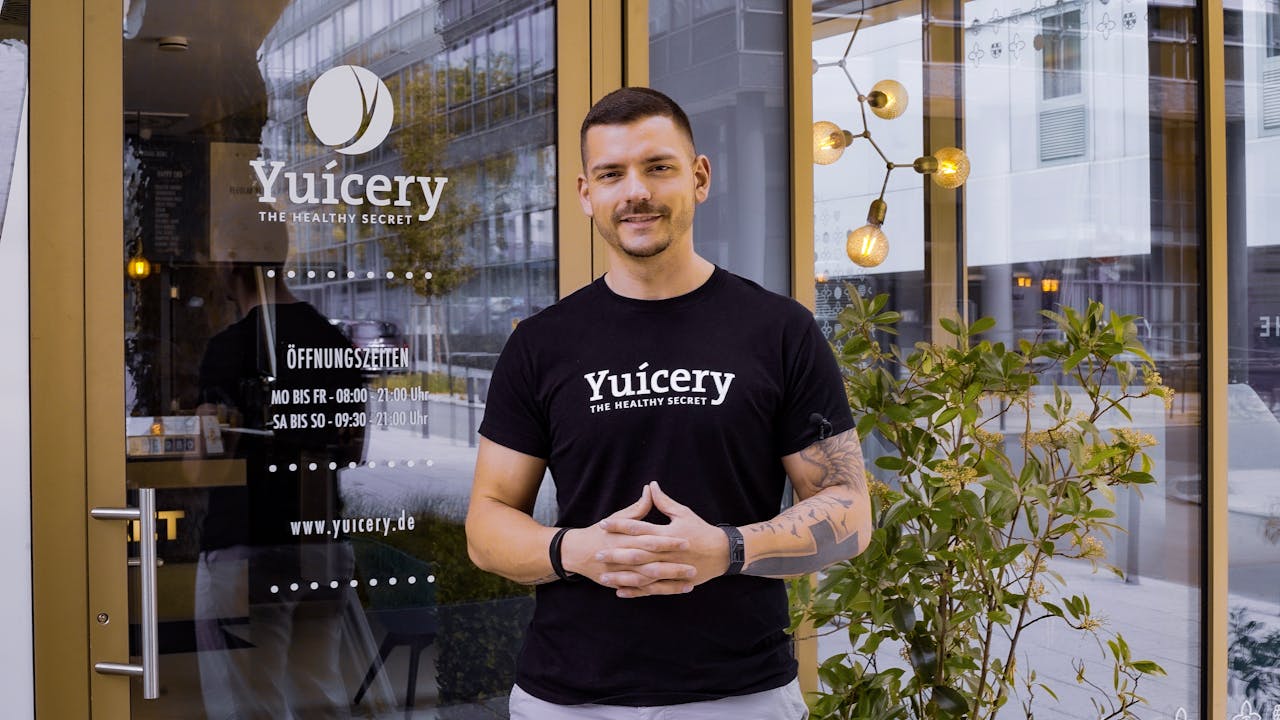
29. Create a Seamless, Touchless Experience
In today’s post-Covid society, consumers are more aware of the dangers of cross-contamination and how viruses are transmitted through touch and are seeking more accessible ways to order from your restaurant.
Fortunately, technology has allowed diners a completely touchless experience, from online reservations to touchless menus to payments.
We have already discussed online reservations, but in the touchless experience, this can be a huge plus.
Guests will not have to stand in a crowd if they are on a wait time.
Likewise, they will not have to touch a pager or worry about interacting with a host or hostess.
Once at their table, visitors can scan a QR code or connect to WiFi to see a digital menu. You can create a QR code using a New Window dynamic QR code generator that is available online. Then, they can use your online app, or a tabletop monitor to order their meal.
Touchless ordering is also an opportunity to capture more opt-in guest data that you can feed into your CDP.
Once their dining experience is complete, they can pay their bill through an online app using Apple Pay, Google Pay, or a similar service.
Creating a touchless experience for your guests can streamline their dining experience and save you time and money by reducing labor costs while decreasing overall table turn times.
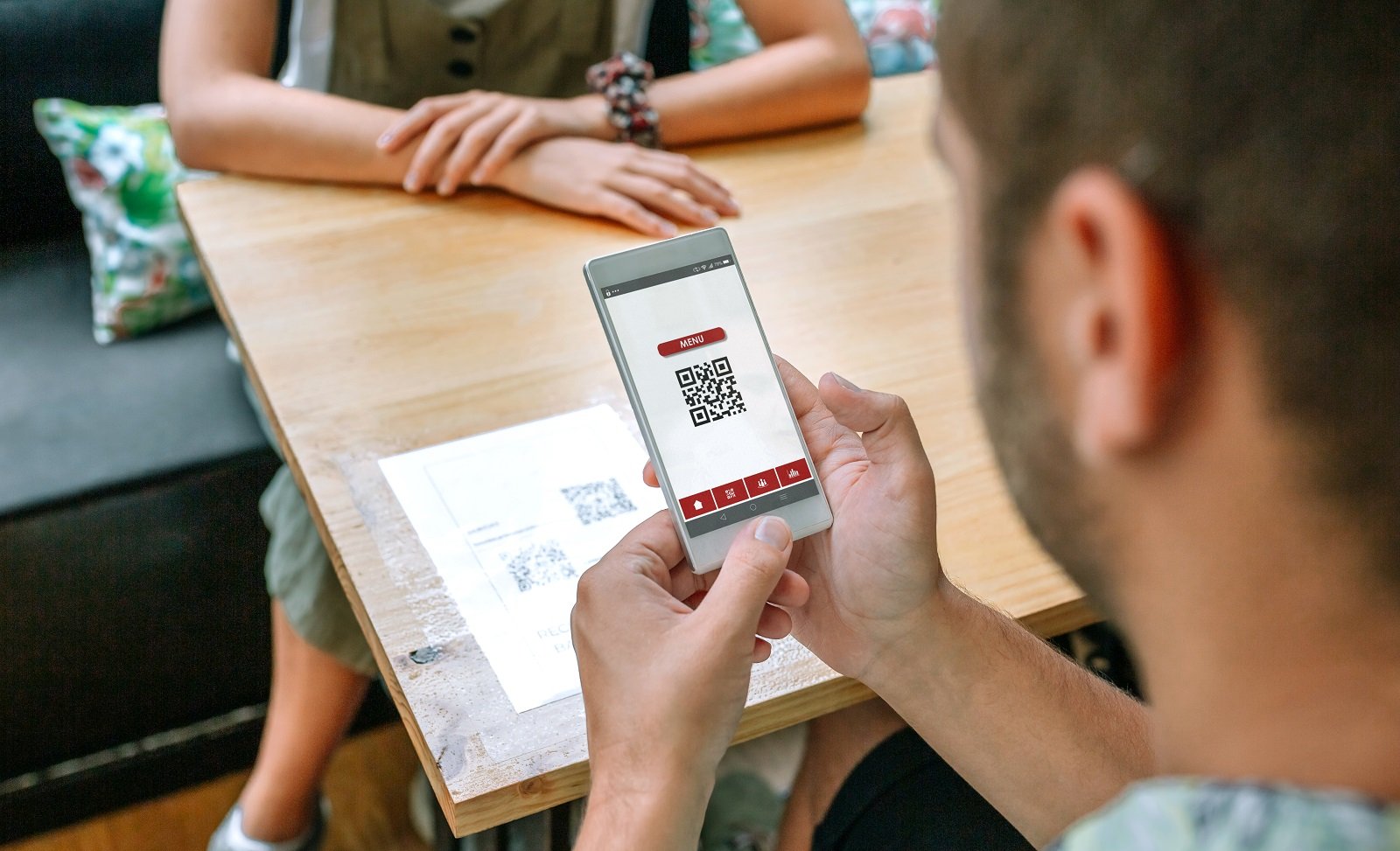
Summary
In the ever-evolving field of restaurant marketing, it’s crucial to stay updated with the latest trends and adopt new and multifaceted strategies to stay competitive in 2024 and beyond.
Embracing emerging technologies like AI, customer data platforms, WiFi marketing, reputation management, and social media experiences can give restaurants a significant edge.
However, effective restaurant marketing goes beyond just adopting the latest trends. It requires a holistic approach that combines data-driven strategies with consistent branding across all customer touchpoints.
By harnessing the power of first-party customer data, restaurants cannot only deliver highly personalized experiences and targeted promotions but also foster lasting relationships with their guests, thereby enhancing their overall guest experience.
Strategic use of social media, online reviews, and influencer partnerships can significantly enhance visibility and engagement. Moreover, the adoption of touchless technologies not only improve guest satisfaction but also boost operational efficiency, a win-win situation for restaurants.
As the industry continues to evolve, staying ahead of the curve requires a willingness to adapt and experiment with new marketing channels and techniques. From influencer marketing to reputation management, the opportunities to connect with diners are vast.
At the heart of successful restaurants are their patrons. By listening to their needs, leveraging data insights, and continuously refining your marketing efforts, you can deliver exceptional guest experiences. Your role is integral in this process.
The marketing landscape may be complex, but the reward for getting it right is a loyal customer base, increased revenue, and a thriving business in an increasingly competitive market.
The good news is that restaurant technology platforms like Bloom Intelligence are leveraging AI and white-glove customer success for their partners to quickly and easily set up a sophisticated and integrated CDP, marketing automation, and reputation management in one platform that delivers actual results.
Once you’ve set up a platform like Bloom Intelligence, you’ll experience the ease and efficiency it brings. It does the heavy lifting for you, consolidating cost structures, and giving back to you your most valuable commodity: your time. This empowers you to focus on what you do best running your restaurant.
By embracing the ideas and trends outlined in this article, whether with a platform like Bloom, manually, or using multiple platforms, restaurants can position themselves for long-term success in 2024 and beyond.
Curious how Bloom Intelligence can elevate your guest experience and restaurant marketing? Click Here for a Free Demo.
SAVE TIME, INCREASE CUSTOMER LIFETIME VALUES, CREATE NEW CUSTOMERS
What our happy customers
are saying
“SaaS that covered so many bases for us instead of having to use multiple software products. Bloom Intelligence has simplified our responses to reviews, customer feedback, and more. I highly recommend Bloom Intelligence.”
Robert Sanderson
“Bloom Intelligence really is a step ahead in terms of marketing software and metrics. Their product is reliable, fast and innovative and has helped the company I work for really grow.”
John Marchetti
“Working with Bloom Intelligence has been amazing. They assist you every step of the way and work with you hand in hand to make sure you are optimizing your advertising potential. We are excited to use this tool to help learn more about our customers so that we can personally engage with them and understand our strengths/weaknesses.”
Ariel Ramirez
“In these challenging times, it has been a pleasure working with Bloom Intelligence to help facilitate our service offering to our clients. They were extremely responsive and provided support to mitigate risk and minimize revenue loss. Great partner!”
Stefan Kim
“We’re extremely pleased with the wealth of customer data that we’re able to gather, at a very attractive price. In addition, we’re able to communicate our new product promotions by using the landing page as a digital billboard. A “no-brainer” for anyone working with limited Marketing $$.”
Bob Cross, Vice President of Operations
How to Market a Restaurant: FAQs
What is the best marketing strategy for restaurants?
Of all the restaurant marketing strategies, perhaps the most effective strategy is using a WiFi marketing and analytics platform. It allows you to collect customer contact information, segment your customer list, create targeted, personalized messaging, and remarket to them for maximum results.
What is restaurant remarketing?
Restaurant remarketing is a powerful way to connect with visitors to your website or customers who have logged into your WiFi. It allows you to send targeted advertising, and behavior-driven promotions to those people through online advertising or email marketing. It’s a key marketing concept that should be a primary focus of restaurant owners and marketers.
What is restaurant marketing segmentation?
Restaurant customer segmentation refers to the process of subdividing a customer base into specific groups based on similar demographics, psychographics, and/or various behavior data points. This information can guide restaurant marketing professionals when developing new marketing campaigns for each group or optimizing existing ones to personalize the customer experience online or at their physical locations.
How do you use smart coupons to market a restaurant?
The best way to implement a digital smart coupon program is to use a WiFi marketing and analytics platform like Bloom. The platform allows you to easily create and send customers a unique, one-time-use code that they can redeem on their next visit. The coupon is stored on their mobile device.
The Power of Restaurant Marketing with Bloom

Optimize retail &
business operations

Track attribution of
customer campaigns

Trigger marketing
campaigns based on
marketing presence

Measure the health
of corporate & franchisee
locations

Compare locations or
group of locations to
quickly identify opportunities
or threats
Are you ready to grow
your restaurant business with
Bloom?
behavior and builds guest loyalty.
It’s time to start leveraging your guest data to gain
a competitive edge. Then watch your profits grow.



